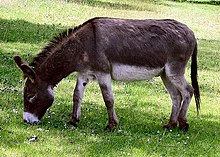

Donkey-hide gelatin or ass-hide glue (Latin: colla corii asini) is gelatin obtained from the skin of the donkey (Equus asinus) by soaking and stewing. It is used as an ingredient in the traditional medicine of China,[1][2] where it is called ejiao (simplified Chinese: 阿胶; traditional Chinese: 阿膠; pinyin: ējiāo), meaning "gelatin of Dong'e County".
The gelatin is produced in several coastal provinces of China: Jiangsu, Zhejiang, Shandong. Shandong's Dong'e County is the source of the name "ejiao".
According to a ca. 1723 account by the French Jesuit Dominique Parrenin, there was a well in Dong'e which was normally kept closed and sealed, and which was only opened when water was taken to be used in preparation of ejiao for the emperor's court.[3]
- ^ Jing-Nuan Wu (2005), An illustrated Chinese materia medica, Oxford University Press, pp. 284–285, ISBN 978-0-19-514017-0
- ^ Xinrong Yang (2003), Encyclopedic Reference of Traditional Chinese Medicine, Springer, p. 168, ISBN 978-3-540-42846-6
- ^ Gobien, Charles Le; Halde, Jean-Baptiste Du; Querbeuf, Yves Mathurin Marie Tréaudet de; Maréchal, Nicolas; Patouillet, Louis (1819), Lettres Édifiantes Et Curieuses, Écrites Des Missions Étrangères: Mémoires de la Chine, Volume 10 of Lettres Édifiantes Et Curieuses, Écrites Des Missions Étrangères, Lettres Édifiantes Et Curieuses, Écrites Des Missions Étrangères (in French) (reprint ed.), J. Vernarel, pp. 479–481 (This is a reprint; the original text was published in the first half of the 18th century. E xian (for Dong'e) and Ejiao are transcribed Ngo-hien and Ngo-kiao, under the transcription system then in use).